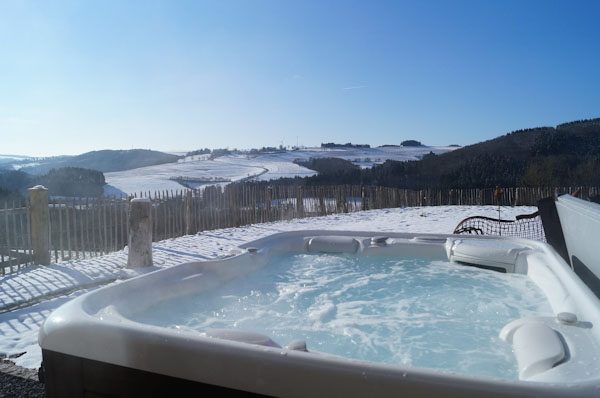
Hot tubs can provide a welcome respite from the cold of winter. After all, nothing feels better than venturing out into the frigid outdoors only to sink into a tub of hot water.
Unless your hot tub is solar powered, though, you’re probably wondering how much it costs to run a hot tub when temperatures drop.
Here, we’ll explain how much it costs to run a hot tub during the winter, as well as steps you can take to reduce costs, no matter how cold it is.
How Much Does It Cost to Heat Up a Hot Tub in Cold Weather?
To figure out exactly how much it costs to run a hot tub in the winter, you first need to find out how much you pay for every kilowatt-hour (kWh) you use.
According to the U.S. Energy Information Administration (EIA), U.S. residents paid an average of 12.95 cents per kWh in November 2018.
Keep in mind that energy prices vary greatly by state and region, though: Residents of Alaska and Hawaii paid 28.59 cents per kWh, while residents of the West South Central region paid just 11.02 cents.
Next, you’ll need to find out much many kWh it takes to heat up your hot tub. To do this, calculate how much energy it takes to fill the number of gallons of water in your hot tub, given that it takes 8.33 British thermal units (BTUs) to heat one gallon of water by 1℉.
So, if your hot tub holds 400 gallons of water, it will take 166,600 BTUs to bring it from 50℉ to 100℉.
Since 166,600 BTUs is equivalent to 48.8 kWh, that means that if you’re paying 12.95 cents per kWh it will cost you $6.32 to heat your hot tub from 50℉ to 100℉.
How Much Does It Cost to Run a Hot Tub in Cold Weather?
The amount of energy it takes to maintain your hot tub’s temperature in cold weather depends on a variety of factors, including how cold it is in your area, where your hot tub is located and how well your hot tub retains heat.
However, unless you plan on using your hot tub several times per week during the winter, or your hot tub is extremely tightly insulated, it will likely be more cost-effective for you to heat up your hot tub before each use than it will be to keep your hot tub running continuously.
Just keep in mind that the colder it is, the longer it will take to heat your hot tub.
On a warm, sunny day, it can take just four hours to heat up your hot tub without a cover. On a cold winter day, it can take up to 16 hours without a cover.
To reduce heating times, be sure secure your hot tub cover before turning the hot tub on.
How to Reduce the Cost of Running a Hot Tub in the Winter
Although it will always be more expensive to run a hot tub in cold weather than it will in warm weather, there are several things you can do to reduce costs.
Invest in a Good Cover
One of the best things you can do to reduce hot tub energy costs in the winter is to invest in a thick, tight-fitting hot tub cover.
The thicker and denser the cover’s foam, the better it will be at preventing heat from escaping.
Additionally, hot tub covers which wrap around the rim of the hot tub (rather than simply sitting on top) are also more effective at retaining heat.
If you live in a very cold area, you may want to get a cover that encapsulates your entire hot tub.
Get a Fully Insulated Hot Tub
If you live in an area where temperatures drop significantly during the winter, it will be well worth the cost to purchase a hot tub that’s fully insulated rather than partially insulated.
This will go a long way towards trapping heat within the hot tub — with partial insulation, heat can easily escape through the sides of the hot tub in cold weather.
Use a Thermal Blanket
Even when you’re using your hot tub, you can use a thermal blanket to conserve energy and keep heat from escaping.
Thermal blankets work by floating on the surface of your hot tub’s water to prevent heat from being released from water that’s not being actively used.
So, unless you have the maximum number of occupants in your hot tub at the same time, you can keep unused space covered with your blanket, thereby helping the water stay hotter and reducing electric consumption.
The bottom line is that while low-quality, poorly insulated hot tubs can be expensive to run during the winter, if you have a high-quality, well-insulated hot tub, then you’ll be able to enjoy relaxing soaks all year round, without breaking the bank.







